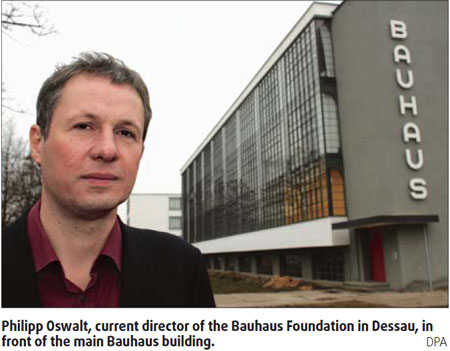
A series of exhibitions around the world will be held to mark the 90th anniversary of the legendary Bauhaus movement, to which luminaries of modern art, like Paul Klee, Lyonel Feininger and Vassily Kandinsky, contributed.
The celebration took off in Weimar, Germany, where the design movement began in 1919. The Workshops for Modernity exhibition is running at the city's Bauhaus Museum, one of the most comprehensive collections of designs from the Bauhaus school.
New York's Museum of Modern Art (MOMA) is heavily tied into the Bauhaus flag-waving, linking its own 80th anniversary celebrations to the Bauhaus' 90th, to produce a Bauhaus 1919-1933: Workshops for Modernity exhibition. The show will run from Nov 8, 2009 to Jan 25, 2010.
MOMA founding director Alfred Barr's visits to the scene of then Bauhaus activity in Dessau, Germany in 1920 was inspirational. Hence the focus on European modernist art when the New York museum, opened shortly before World War II.
Touted as the biggest Bauhaus show ever by the organizers, this will be an enlarged version of the Model Bauhaus show Berlin plans this summer at the city's Martin Gropius Bau exhibition center.
The Bauhaus' enduring appeal lies in the fact that besides more conventional fields of art, early pioneers focused on furniture, industrial design, the stage, in fact, just about anything that lent itself to innovative designing.
Or, as Lisbeth Oestreicher, a former Bauhaus graduate, says: "It was the school that shaped the image of the modern age."
Also the works of teachers and students who fled Germany after 1933 helped keep the Bauhaus legend alive. Although Dessau was badly damaged in the war, it remains one of the best sites of Bauhaus architecture. A number of its classical Bauhaus buildings mercifully survived war-time bombing.
The Bauhaus was founded by renowned German architect Walter Gropius in Weimar in April 1919, but suffered political persecution from the rightists.
In 1924 drastic municipal cuts in funding forced it to move to the more hospitable Dessau, north of Weimar.
This was where Gropius created the impressive Bauhaus Building, now a UNESCO-listed structure, for the creative commune. With a spectacular college complex, it soon inspired a wave of splendid 20th century buildings in leafy neighborhoods, some of which still survive.
But by 1932 Dessau was in the clutches of the Nazis, which meant the Bauhaus had to cease work.
Architect Mies van der Rohe, the third director of the Bauhaus, hastily rallied private funds, enabling it to transfer to the former factory premises in Berlin.
But less than a year later, on July 20, 1933, storm troopers and the Gestapo surrounded the building, sealing it, and arresting 32 students.
Several of its pioneers died later in Nazi concentration camps. The Bauhaus were around for just 14 years but art critics concede its sustained influence.
For a long time after the War, little was heard of Dessau, badly damaged in the war. However, after German unification in 1990, it saw a cultural renaissance.
The Bauhaus Building itself was splendidly refurbished after years of communist neglect, serving as a college and museum.
In 1994, the Bauhaus Dessau - an institution which since 1990 was a partner in international East-West projects - was converted into a foundation for international students.
Lately it has gained a new director, Frankfurt-born Philipp Oswalt. His first projects include a Bauhaus in Conflict book, a symposium on the correlation between the financial market crisis and architecture, and an artist-in-residence program.
The Bauhaus Dessau will be further developed as an international and interdisciplinary platform for researchers and designers and will hold a 10-day international Summer School, he says.
(China Daily/DPA, April 28, 2009)